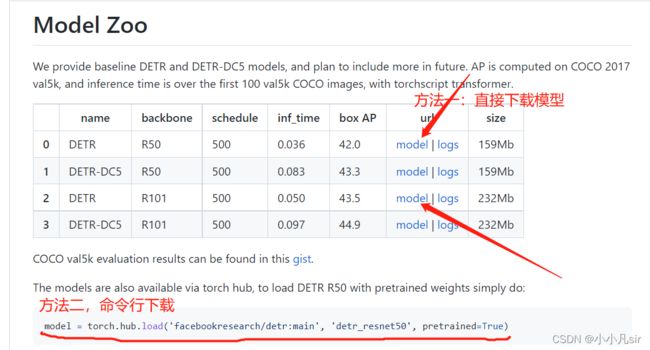如何用DETR(detection transformer)训练自己的数据集
DETR(detection transformer)简介
DETR是Facebook AI的研究者提出的Transformer的视觉版本,是CNN和transformer的融合,实现了端到端的预测,主要用于目标检测和全景分割。
DETR的Github地址:https://github.com/facebookresearch/detr
DETR的论文地址:https://arxiv.org/pdf/2005.12872.pdf
DETR训练自己数据集
数据准备
DETR需要coco数据集才可以进行训练,需要将数据标签和图片保存为如下格式:
其中,annotations是如下json文件,

test、train和val2017存储的只有图片。
那么要如何得到coco数据集格式的文件呢,接下来我提供两种方法:
coco数据集获取
1、labelme打好json文件后转换为coco格式数据集
2、roboflow标注后直接生成coco格式数据集(需要连外网,需要的联系我可以免费给你提供好用的外网扩展程序)。roboflow网址:https://app.roboflow.com/
然后介绍如何用labelme转换数据集,首先在cmd python环境或者在pycharm终端输入pip install labelme,下载好后输入labelme进入打标签页面,打好标签后生成json文件,再运行如下脚本:
import argparse
import json
import matplotlib.pyplot as plt
import skimage.io as io
from labelme import utils
import numpy as np
import glob
import PIL.Image
class MyEncoder(json.JSONEncoder):
def default(self, obj):
if isinstance(obj, np.integer):
return int(obj)
elif isinstance(obj, np.floating):
return float(obj)
elif isinstance(obj, np.ndarray):
return obj.tolist()
else:
return super(MyEncoder, self).default(obj)
class labelme2coco(object):
def __init__(self, labelme_json=[], save_json_path='./tran.json'):
self.labelme_json = labelme_json
self.save_json_path = save_json_path
self.images = []
self.categories = []
self.annotations = []
# self.data_coco = {}
self.label = []
self.annID = 1
self.height = 0
self.width = 0
self.save_json()
def data_transfer(self):
for num, json_file in enumerate(self.labelme_json):
with open(json_file, 'r') as fp:
data = json.load(fp) # 加载json文件
self.images.append(self.image(data, num))
for shapes in data['shapes']:
label = shapes['label']
if label not in self.label:
self.categories.append(self.categorie(label))
self.label.append(label)
points = shapes['points'] # 这里的point是用rectangle标注得到的,只有两个点,需要转成四个点
points.append([points[0][0], points[1][1]])
points.append([points[1][0], points[0][1]])
self.annotations.append(self.annotation(points, label, num))
self.annID += 1
def image(self, data, num):
image = {}
img = utils.img_b64_to_arr(data['imageData']) # 解析原图片数据
# img=io.imread(data['imagePath']) # 通过图片路径打开图片
# img = cv2.imread(data['imagePath'], 0)
height, width = img.shape[:2]
img = None
image['height'] = height
image['width'] = width
image['id'] = num + 1
image['file_name'] = data['imagePath'].split('/')[-1]
self.height = height
self.width = width
return image
def categorie(self, label):
categorie = {}
categorie['supercategory'] = 'Cancer'
categorie['id'] = len(self.label) + 1 # 0 默认为背景
categorie['name'] = label
return categorie
def annotation(self, points, label, num):
annotation = {}
annotation['segmentation'] = [list(np.asarray(points).flatten())]
annotation['iscrowd'] = 0
annotation['image_id'] = num + 1
# annotation['bbox'] = str(self.getbbox(points)) # 使用list保存json文件时报错(不知道为什么)
# list(map(int,a[1:-1].split(','))) a=annotation['bbox'] 使用该方式转成list
annotation['bbox'] = list(map(float, self.getbbox(points)))
annotation['area'] = annotation['bbox'][2] * annotation['bbox'][3]
# annotation['category_id'] = self.getcatid(label)
annotation['category_id'] = self.getcatid(label) # 注意,源代码默认为1
annotation['id'] = self.annID
return annotation
def getcatid(self, label):
for categorie in self.categories:
if label == categorie['name']:
return categorie['id']
return 1
def getbbox(self, points):
# img = np.zeros([self.height,self.width],np.uint8)
# cv2.polylines(img, [np.asarray(points)], True, 1, lineType=cv2.LINE_AA) # 画边界线
# cv2.fillPoly(img, [np.asarray(points)], 1) # 画多边形 内部像素值为1
polygons = points
mask = self.polygons_to_mask([self.height, self.width], polygons)
return self.mask2box(mask)
def mask2box(self, mask):
'''从mask反算出其边框
mask:[h,w] 0、1组成的图片
1对应对象,只需计算1对应的行列号(左上角行列号,右下角行列号,就可以算出其边框)
'''
# np.where(mask==1)
index = np.argwhere(mask == 1)
rows = index[:, 0]
clos = index[:, 1]
# 解析左上角行列号
left_top_r = np.min(rows) # y
left_top_c = np.min(clos) # x
# 解析右下角行列号
right_bottom_r = np.max(rows)
right_bottom_c = np.max(clos)
# return [(left_top_r,left_top_c),(right_bottom_r,right_bottom_c)]
# return [(left_top_c, left_top_r), (right_bottom_c, right_bottom_r)]
# return [left_top_c, left_top_r, right_bottom_c, right_bottom_r] # [x1,y1,x2,y2]
return [left_top_c, left_top_r, right_bottom_c - left_top_c,
right_bottom_r - left_top_r] # [x1,y1,w,h] 对应COCO的bbox格式
def polygons_to_mask(self, img_shape, polygons):
mask = np.zeros(img_shape, dtype=np.uint8)
mask = PIL.Image.fromarray(mask)
xy = list(map(tuple, polygons))
PIL.ImageDraw.Draw(mask).polygon(xy=xy, outline=1, fill=1)
mask = np.array(mask, dtype=bool)
return mask
def data2coco(self):
data_coco = {}
data_coco['images'] = self.images
data_coco['categories'] = self.categories
data_coco['annotations'] = self.annotations
return data_coco
def save_json(self):
self.data_transfer()
self.data_coco = self.data2coco()
# 保存json文件
json.dump(self.data_coco, open(self.save_json_path, 'w'), indent=4, cls=MyEncoder) # indent=4 更加美观显示
labelme_json = glob.glob(r'./*.json')
# labelme_json=['./1.json']
labelme2coco(labelme_json, '.\\instances_val2017.json')
这个脚本是我之前在别人CSDN找的,比较好用。
预训练文件下载
有了数据集后,为了加快学习速度,可以去官网下载预训练模型,官网提供的有resnet_50和resnet_101两个预训练版本,下载后得到pth文件。下载如下:

修改detr-main文件的一些配置
因为detr是针对的是91(数字可能错了,不是记得了)个目标进行预测,所以我们在进行预测的时候,需要把目标预测数目改为自己的需要检测目标的数目。首先需要修改上一步下载好的pth文件,运行如下脚本:
import torch
model1 = torch.load('detr-r101-2c7b67e5.pth')
num_class = 2 #我只需要检测一个物体,所以是2(检测个数+background)
model1["model"]["class_embed.weight"].resize_(num_class+1, 256)
model1["model"]["class_embed.bias"].resize_(num_class+1)
torch.save(model1, "detr-r50_test_%d.pth"%num_class)
然后还需要修改detr.py文件夹下的num_classes,

训练模型
训练模型这块,可以直接执行命令行,或者在main.py里面修改好参数后运行,
官方提供的命令行如下:
python -m torch.distributed.launch --nproc_per_node=8 --use_env main.py --coco_path /path/to/coco
结束语
我觉得在训练那块还是改main.py文件比较好,需要改的地方挺多,我觉得需要修改的主要有–epoch(轮次)、–num_workers(主要看你电脑性能怎么样,好点可以调高些)、–output_dir(输出的模型权重,pth文件)、–dataset_file(数据存放位置)、–coco_path(coco数据集的位置)和–resume(预训练权重文件位置)。
还一点就是官方只提供了训练脚本,但是没预测脚本,其实预测脚本也挺简单的,就是加载模型,加载权重参数,然后传入图片预处理什么的,代码挺多的,放上来内容太多了,我写了两个预测脚本,需要的可以联系我,或者不会运行的可以问我,其实也挺简单的,多玩几次就会了~~
最后展示下效果吧,预测的还是挺准的
